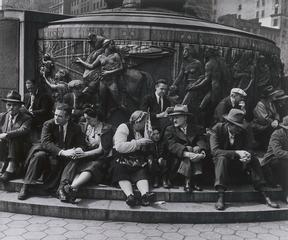| 2 of 10 |

| Liebling and The Photo League | |
|
“Liebling’s work shows us not the world of objective facts, but his own experience of the world. In the angle of vision, the man reveals himself.” – Alan Trachtenberg (for Liebling portfolio), 1976 |
The people on these steps have come to Union Square in New York City to watch a parade. The picture records them seated together beneath a public monument but seemingly lost in their own private daydreams as they wait for the parade to start. Alan Trachtenberg, in his introduction to Jerome Liebling Photographs, describes it:
Clutching knees or a newspaper, holding chins or each other’s hands, the individuals of the seated group make up a frieze, a human tapestry without an obvious legend; they gaze outward or muse inward on some unvoiced private story. And they sit beneath another frieze, the bas-relief of the monument, an allegory of a parade drawn into a shining future by a holy child, a goddess of peace, and a winged horse of victory. The figures are mythical and the message patriotic. The inscription is pure oratory: “How little do my countrymen know . . .”
(Alan Trachtenberg,Jerome Liebling Photographs, 1982)
Could the photograph be asking, “How little do my countrymen know of each other?” Trachtenberg points out that the picture plays the monument’s patriotism against the street, where real-life patriots sprawl on the steps.
Pictures like this one place Jerome Liebling in the tradition of social documentary photography. The picture goes beyond showing what the camera sees. A social document comments on society, and in doing so, reveals the photographer’s point of view.
| 2 of 10 |
